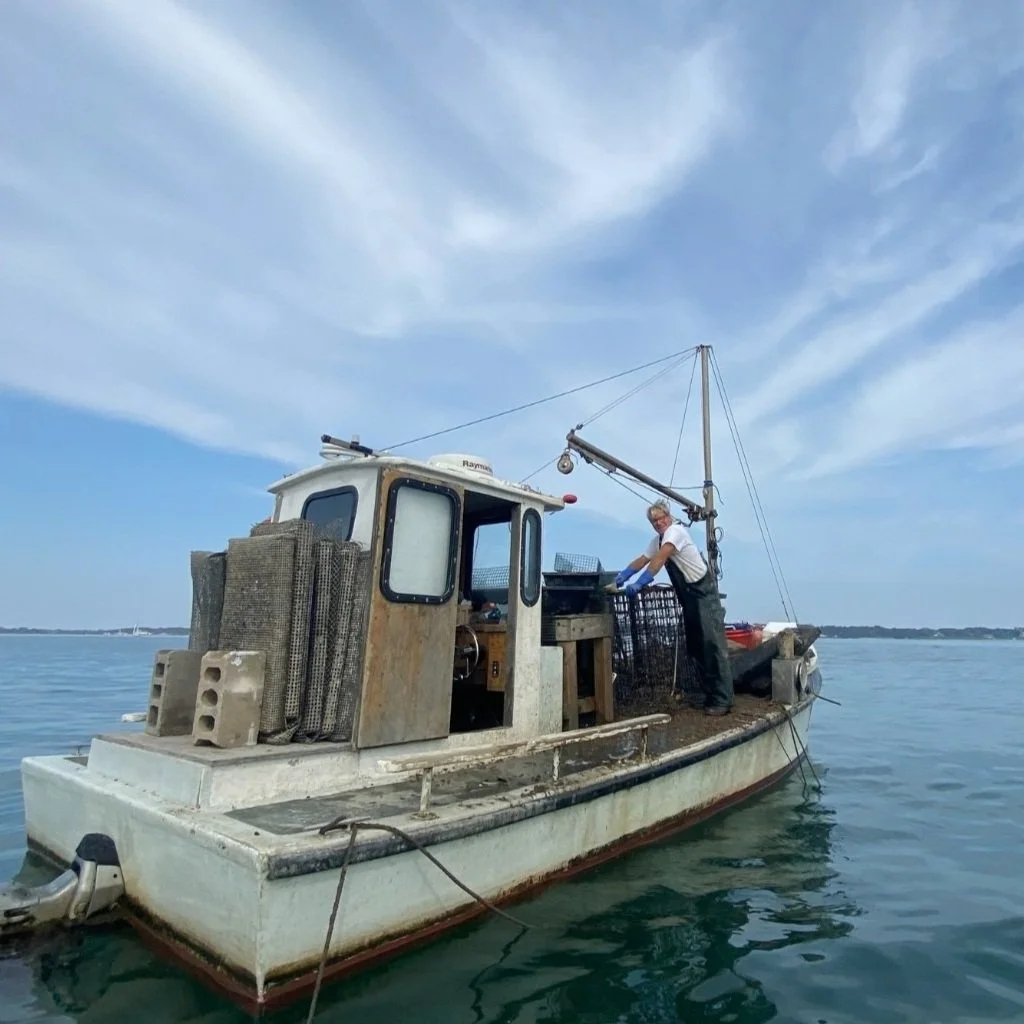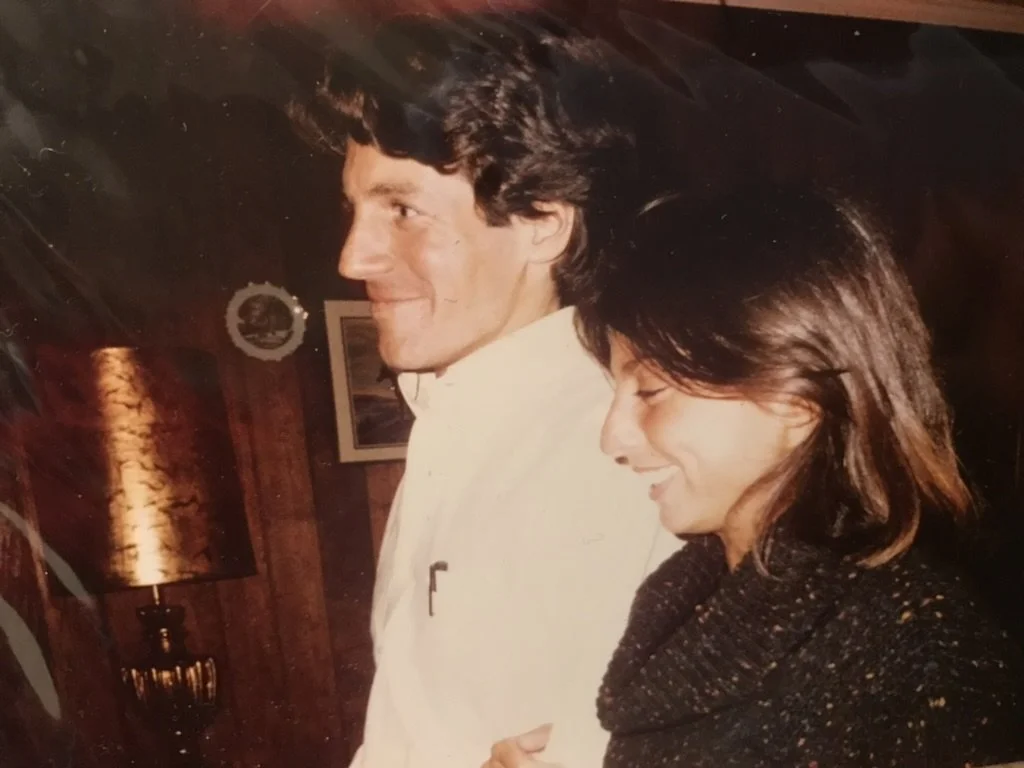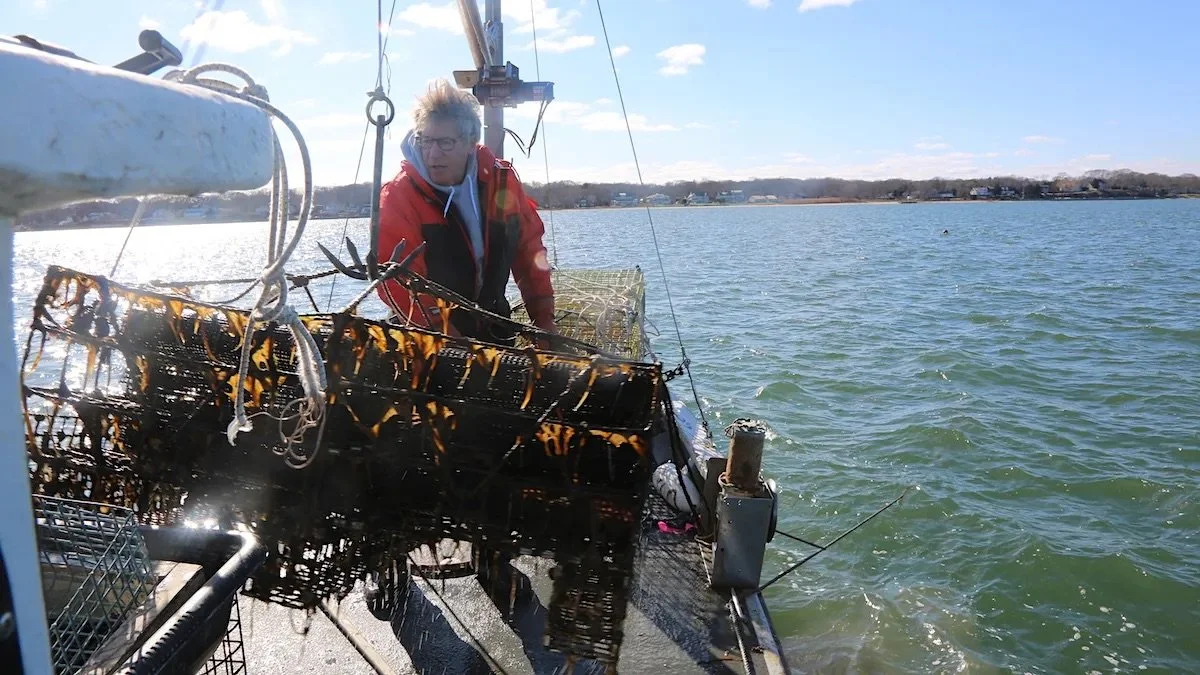On the Half-Shell: A Career Journalist’s Last Course [full]
From humble beginnings on Brooklyn’s Belt Parkway to a four-decade career in broadcast journalism, this Jewish oyster farmer reflects on life and love along the water’s edge.
Steve Schnee in action on the Gray Hawk. Photo provided by Steve Schnee.
Steve Schnee is an oyster farmer on the East End of Long Island. His aquaculture operation, named Founders Oyster Farm after the underwater plot’s location, is just a mile off of Founders Landing on the Peconic Bay.
This is now his bread and butter, a stark contrast to the nearly forty years spent in network television as a field producer. Steve just turned 70 and spends his mornings on the water, dressed in clay-stained Grundéns, braving the winter winds. He traded in his press pass for lined rubber gloves that keep the shells from cutting into his skin. His farm is family-owned-and-operated, mostly by himself. He’s dropped his glasses into the water more than once. He is also my dad.
Brooklyn Beginnings
Born to two second-generation Ashkenazi Jews, Steve was raised mostly secular. His mother, Bernice, was the first and only in her family to go to college, a progressive feat at the time. She went on to become an art teacher and dedicated potter.
Her mother was raised in an orphanage—not because she was without parents, but because the cost of feeding and clothing children was too high for many families. My dad’s maternal grandparents kept kosher in the home, but on special occasions, they’d go to Lundy’s in Sheepshead Bay for lobster to indulge in treif, all three generations.
Bernice met her husband Murray, who grew up in Williamsburg tenement housing, at a summer camp where the two worked. Later they’d tell Steve that the sound of cars whizzing past their ground floor apartment was actually Jamaica Bay’s waves on the other side of Belt Parkway.
Bernice in front of their Chautauqua housing. Photo provided by Steve Schnee.
Murray was a gifted violinist who made it into the New York City Ballet Orchestra. When he was off-season at Lincoln Center, he played for the Chautauqua Symphony right below the Canadian border. Each summer, Bernice, Murray, and their three kids (affectionately referred to as Ix, Mix, and Drix) loaded up their station wagon and drove nine hours upstate. This was a rare and fortunate opportunity for their three children to be exposed to art, literature, and water on a modest musician’s salary, right off of Lake Erie. The food was markedly terrible, but Davie’s Fish Fry offered mediocre shellfish on a Friday night.
Two Young Journalists
Their drives north always circumvented Alfred University, where Steve enrolled with a major in Political Science and minor in Ceramics. His first job out of college surprised everyone; originally, he wanted to go to law school, but in 1976, television networks were hiring lots of additional staff to cover the conventions. He got a job as a desk assistant for ABC News and discovered his love for storytelling and investigative journalism. While the first handful of years mostly involved grunt work, Steve eventually went from researcher, to production assistant, to associate producer, and ended up moving to Atlanta as the bureau’s field producer covering the Southeastern US, Central America, and South America.
In 1982, he was sent to Buenos Aires on assignment to cover the Falklands War—which, now, he instinctively calls the Malvinas. The crew was on a stakeout outside of the Ministry of Defense when a couple of Argentine journalism students, on their way to university, stopped to chat. One of them was my mother, Monica, a simultaneous legal translator and fiercely political young woman—who was also, coincidentally, Jewish. Her family ate Sephardic treif: chinchulín, chorizos, and non-Kosher meat in every asado. Their budding relationship helped him understand the complexities of true storytelling: my tío Julio was a conscript at risk of being drafted to fight against the British, while their English Grandma Joyce, who’d arrived in Argentina in her twenties, had a suitcase packed by the door just in case.
Monica emigrated a year later to live with Steve in Atlanta. Those five years in Georgia were difficult for her—until they married, she couldn’t work. She was homesick and there were no Latin Americans, let alone Sephardic Jews, for miles. But Steve’s repeated requests to transfer to the London bureau were finally met, and the two moved to a city that they could quickly settle into. My mom had family close by, and many Latin Americans, who had the good fortune, were beginning to flee the continent in search of more stability, safety, and opportunity.
A Career of Meaning
Monica and Steve getting married by the Justice of the Peace, Atlanta. Photo provided by Steve Schnee.
ABC News was one of the first and most committed networks covering international news. “It was a great opportunity, and time to be a journalist overseas.” Monica freelanced as a producer and on-air reporter for the Latin American divisions of major networks. She and Steve were dedicated to truth-telling, and they traveled thousands of miles to do it.
They were in Berlin when the wall came down, and Soweto when Nelson Mandela was released from prison. Just after my brother was born, Steve flew to Sudan to cover the 1993 famine, where food was hijacked and used as a weapon, aid agencies forced to pay ransom to feed starving children. When my mom was pregnant with me, his hotel in Baghdad was hit by a cruise missile, and it took days to find out he was okay. He covered the Rwandan Genocide from Zaire after a quick stop in London to cut my umbilical cord. He was nominated for three Emmys and won two. Steve knew how essential this work was—and continues to be—but eventually it wore into him.
“It was a great opportunity, and time to be a journalist overseas.”
On Saturday mornings, when the phone would ring, he’d get a pit in his stomach fearing it was the assignment desk calling to send him off again. But it was just my tío Julio calling to play tennis. In 1997, he was offered a new role: the news magazine 20/20 was just starting up a second hour program, so he moved with his family back to New York.
Finding Joy
“The stories that touch your heart,” was 20/20’s motto. These were longer pieces, with rich central characters from all over the world. He loved this work too, and it let him cover more joy and less tragedy. But fifteen years later, ABC downsized half of its staff. This was a major cost-cutting that all the networks went through and with it went experienced seasoned journalists.
With two kids in college and a mortgage, Steve did a year and a half at CNBC, freelanced a project for the UN on counterfeit medicine in Africa, went to the South Pacific on a search for Amelia Earhart’s remains, and even started a small production company of his own, but it was clear this chapter was nearing its end.
Photo provided by Steve Schnee
Reflecting back on his time in the field, Steve said, “It was the greatest run in the world. That was the golden age of journalism: the industry was growing, and people really respected the work. We were telling the truth. It was before it became a business.”
Looking down, he added, “Now journalists are referred to as ‘the enemy of the state,’ and the press is getting torn up by the incoming administration. They’re facing different dangers.”
Act Two
When his last child graduated college (me), Steve’s lifelong interest in the water finally came to fruition. Oyster farming started as a hobby, and a place for him to escape to while searching for work in a rapidly changing media landscape. He started spending more time on the North Fork and volunteered at S.P.A.T., Cornell’s Suffolk Project in Aquaculture Training, where he learned the art and science of growing oysters.
Eventually, he mustered the courage to bet on himself and decided to make a go of it through Suffolk County’s lease programs. For the last decade or so, a lot of people have started oyster farms along the East End, in hopes of improving water quality and making a living.
Steve made his love of the water a full-time gig. He even restored a 1936 Chris Craft to take passengers out for an oyster cruise so they can shuck them open fresh from the farm, but it’s really Steve who enjoys it the most. Before Bernice died in 2022, she would easily slurp down a dozen of her favorite treif and say, “What would my Murray think of this,” with a knowing smirk.
Steve on the oyster farm. Photo provided by Felicia LaLomia.





